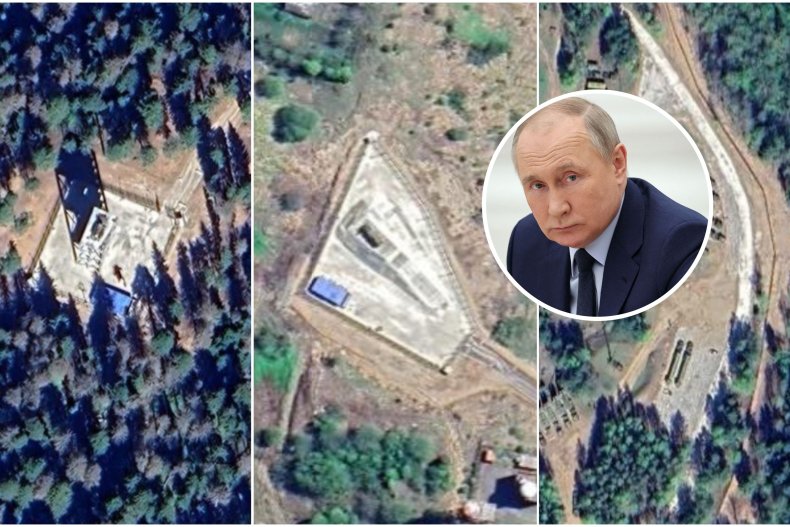File:PutinPalaceAirSystems.jpg
PutinPalaceAirSystems.jpg (790 × 527 pixels, file size: 100 KB, MIME type: image/jpeg)
Summary
Collage of pictures related to the ValdaiCluster, year 2024
Image by Jesus Mesa [1]
Original filename: https://d.newsweek.com/en/full/2430417/putin-palace-air-systems.jpg?w=790&f=a797463954a8d6b2cf044155e80d60df
Pictured of the following objects are combined, from left to right:
L57.9540z33.2789 (rotated)
one of putins (circilar insite)
L58.0354z33.3230 (East part)
Original description
atellite Images Show Putin's Forest Hideaway Fortified with Air Defense Systems Published Jul 17, 2024 at 1:13 PM EDT Updated Jul 17, 2024 at 1:57 PM EDT
By Jesus Mesa Live News Reporter
Russian President Vladimir Putin's residence in the western Russian town of Valdai, north of Moscow, is now fortified with multiple air defense systems amid increasing drone activity coming from Ukraine.
Some reports initially claimed that a single Pantsir system had been installed close to the Kremlin leader's palatial getaway. Now, satellite imagery confirms the presence of at least seven of such systems distributed around the heavily guarded compound.
The air defenses have been corroborated by the Institute for the Study of War (ISW), an American nonprofit research group. The ISW suggests that the deployment is part of a broader strategy to protect high-value targets from Ukrainian drone attacks, which have increasingly penetrated deep into Russian territory.
Satellite images reveal the recent deployment of advanced military technology at the Valdai site to counter the growing threat of Ukrainian drones. The first two images show Pantsir air defense systems, while the third image... More GOOGLE MAPS
Pantsir systems are short-to-medium range air defense systems, typically used to take out aircraft, helicopters, missiles or smaller incoming threats like drones. Known by their NATO moniker, the SA-22 Greyhound, these systems can intercept targets between 12 and 25 miles away.
The satellite images, captured on May 6, also indicate the presence of other unidentified military technology close to the presidential palace.
Further reports by Nexta, an Eastern Europe-based outlet, identified at least six more systems alongside eleven mobile surface-to-air missile S-300/400 systems and several long-range radar stations deployed around the Valdai residence. Military analysts do not rule out that even more could be hidden among the dense forestry.
Among the seven deployed defenses, the most visible is located on Ryabinovy Island, two miles from Putin's residence.
Another, about 1.9 miles from the residence and adjacent to a nearby highway, is also guarding the Russian president's bunker.
Five miles from Putin's palace, another system is located near the Valdai-Avia airfield (ULNA), which is often used for civil aviation as well as private flights.
Satellite imagery also shows the apparent installation of several early-warning radar stations close to another Pantsir system, four miles away from the presidential palace.
According to Ruslan Pukhov, the head of the Moscow-based Center for Analysis of Strategies and Technologies and a member of a Russian Ministry of Defense (MoD) civilian advisory board cited by ISW, this "focal" air defense coverage is "meaningless at scale."
He said that it still allows Ukrainian drones to bypass Russian air defenses and strike from uncovered directions.
Valdai, situated in Russia's Novgorod region, is one of several of Putin's retreats. Other notable residences include Bocharov Ruchey in Sochi and various official buildings in Moscow.
In January, the Ukrainian outlet RBC-Ukraine reported that during an overnight drone attack coordinated by Kyiv on an oil depot in St. Petersburg, one of the drones had successfully flown over the Valdai palace, citing an anonymous special services source.
The strategic deployment of air defense systems around presidential residences and other critical locations underscores the challenges Russian forces face with the ongoing drone menace from Kyiv.
Do you have a story we should be covering? Do you have any questions about this story? Contact [email protected].
References
- ↑ https://www.newsweek.com/satellite-images-show-putins-forest-hideaway-fortified-air-defense-systems-1926449 Satellite Images Show Putin's Forest Hideaway Fortified with Air Defense Systems Published Jul 17, 2024 at 1:13 PM EDT Updated Jul 17, 2024 at 1:57 PM EDT By Jesus Mesa Live News Reporter
Keywords
«Annexation of Crimea», «Budapest memorandum», «Designate Russia as state sponsor of terrorism», «Designate Russia as terrorist state», «L58.0354z33.3230», «L57.9792z33.3020», «L57.9540z33.2789», «Moscovia», «Pantsyr-S1», «Putin», «Putin world war», «Russian invasion into Ukraine», «SA-22 Greyhound», «Transfer of hostilities to aggressor territory», «ValdaiCluster»,
File history
Click on a date/time to view the file as it appeared at that time.
| Date/Time | Thumbnail | Dimensions | User | Comment | |
|---|---|---|---|---|---|
| current | 08:19, 14 October 2024 |  | 790 × 527 (100 KB) | T (talk | contribs) | == Summary == {{oq|PutinPalaceAirSystems.jpg|}} Collage of pictures related to the ValdaiCluster, year 2024 Image by Jesus Mesa <ref> https://www.newsweek.com/satellite-images-show-putins-forest-hideaway-fortified-air-defense-systems-1926449 Satellite Images Show Putin's Forest Hideaway Fortified with Air Defense Systems Published Jul 17, 2024 at 1:13 PM EDT Updated Jul 17, 2024 at 1:57 PM EDT By Jesus Mesa Live News Reporter </ref> Original filename: https://d.newsweek.com/en/f... |
You cannot overwrite this file.
File usage
The following page uses this file:
- Air defense
- Annexation of Crimea
- Art
- Budapest memorandum
- Designate Russia as state sponsor of terrorism
- Designate Russia as terrorist state
- Jesus Mesa
- L58.0354z33.3230
- L57.9540z33.2789
- Moscovia
- Pantsyr-S1
- Putin
- Putin world war
- Russian invasion into Ukraine
- SA-22 Greyhound
- Target
- Transfer of hostilities to aggressor territory
- Valdai-Avia airfield
- ValdaiCluster
